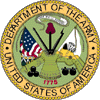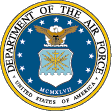Do Military Command Information Newspapers Meet State Goals and Objectives They Claim to Advocate?
| Department
of Defense |
| Joint
Course in Communication |
| University
of Oklahoma -- Class 03A2 |
 |  |  |  |
|
Table of Contents:
| |||||||||
| Authors: |
| Jessica
Bailey, U. S. Navy |
| Marisol
Cantu, U. S. Marine Corps |
| Sharon
Chan, U. S. Navy |
| Masao
Doi, U. S. Air Force Civilian |
|
Robert
Whetstone, U. S. Army |
This website was constructed as part of a research project under the auspices of the University of Oklahoma. It does not necessarily reflect the views or policies of the Department of Defense.
| The
purpose of this paper is to determine if military command information
newspapers meet stated goals and objectives they advocate. Newspapers as we know them have been in existence since 1702. Usage in the military became prominent during the Civil War. Even though these were local newspapers, coverage consisted of information that would be considered today as command information (information developed and dispersed to an internal audience). Contents usually consisted of desertions, arrivals at key cities and hotels, deaths, and lists of those wounded in battle. The greatest initial task of America’s participation in World War One was to get the many tongues of the nation to speak the same language of loyalty and patriotism (Schelsinger, 1919, p. 350). Beginning with September 1917, the camps and cantonments in the U.S. gave birth to more than 60 full-fledged newspapers (Schelsinger, 1919, p. 350). Today, military newspapers total over 175. Not much has changed since then, only public affairs practitioners must deal with a much more sophisticated and educated audience. During the Mexican War, military newspapers were also found in many of the camps (Schelsinger, 1919, p. 351). The Army under General Winfield Scott had its own publication known as the American Flag, and there were other papers such as the Sentinel, American Star, Picket Guard and the Eagle (Schelsinger, 1919, p. 351). Newspapers sprung up everywhere the military went, and with the boom of the internet, this trend continues, albeit slightly different from yesteryear. Keeping the military community informed continues to be a clarion call in the hyper-quick information age we live in. The armed services are greatly challenged to provide timely, accurate information to their internal audience with maximum disclosure and minimum delay. Also within this charter, the services must ascertain whether the tools used to provide this information meets the goals and objectives stated in service regulations. In the military, higher commands set goals to be obtained by its subordinates. In keeping with this ideology, the DoD sets goals of information for the services. These goals are to: 1. Insure timely and accurate information is available to the public. 2. Information will be made fully available in concert with provisions of the Freedom of Information Act and the Privacy Act. 3. Information will be made available without censorship or propaganda. 4. Information will not be classified or withheld to protect the government from criticism or embarrassment. 5. Information will be withheld only when disclosure would adversely affect national and operations security or threaten a service member’s safety or privacy. 6. DoD maintains an obligation to provide the public with information on its major programs. In order to meet these goals the individual services lay down specific objectives. One might ponder that the uniqueness of each service would call for differing objectives. Since DoD provided direction, the objectives of each of the four services are very similar in scope and nature. The objectives outlined for this paper are: 1. Military newspapers provide the commander a primary means of communicating mission-essential information to members of the command. They provide feedback to the commander. Newspapers keep readers informed about the installation, local community, military family issues and operational concerns. They provide a communication channel for responding to installation-wide concerns. 2. News and feature stories on military personnel and organizations provide recognition of excellence in performance, help set forth expected norms and motivate people for mission accomplishment. 3. Improve morale by helping quell rumors and keep personnel accurately informed about military matters affecting their futures. 4. Newspapers provide information to family members to improve the quality of their lives and the effectiveness of the services. 5. Newspapers increase command cohesiveness and effectiveness by providing a visual representation of the command (AFI 35-101, Public Affairs Polices and Procedures, date, page). | |
|
| |
|
| |
|
| |